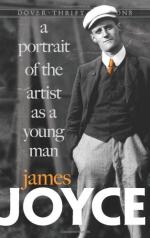|
|
A Portrait of the Artist as a Young Man Author/Context
The printer who was to make copies of James Joyce's first book of stories, Dubliners, refused to do so, saying he would not print indecent material. Joyce, only twenty-four at the time, responded, "I seriously believe you will retard the course of civilization in Ireland by preventing the Irish people from having one good look at themselves in my nicely polished looking glass." (Norris 56) Never modest and always ambitious, James Joyce did go on to leave his distinctive mark not only on Irish literature, but on all of Western literature. His work was so epic, so strange and beautiful and surprising that when the Romanian artist Brancusi went to draw a portrait of Joyce he had to draw two. The first was a sketch of the artist's face; the second was a swirly line, twisting outward in ever-increasing circles from its center, a shape both graceful and mysterious.
Joyce was born in Dublin, Ireland, the city that inspired his fiction, in 1882. This was nearly twenty years before the death of Queen Victoria, a time when all lands west of the English Channel were in the midst of religious and moral conflict. Ireland was in great turmoil at this time, as the country tried to shake free from the lingering influence of the English and define itself as a distinct entity with its own language and history. As a boy, Joyce roamed Dublin alone and with his father, walking past buildings that had been fine dwellings of the aristocracy a hundred years before, but had, as a result of various conflicts, been abandoned to tenement occupation. Joyce's father filled his son's memory with songs and stories, with religious, historical and political material, all of which made its way into Joyce's novels later in life.
A Portrait of the Artist as a Young Man was drafted in rough form in 1904, when Joyce sat down and in one day wrote an autobiographical sketch. Before it evolved into its current short, five-section form, the novel was a thousand-page version titled Stephen Hero. The novel is to some degree autobiographical, though how much so is debatable. Certainly Stephen and Joyce share many life details. Like Stephen, Joyce was raised by a kind mother and a father who drank and had constant money troubles. Also like Stephen, Joyce attended Clongowes Wood College and then Belvedere College, and he went on to the University College, Dublin, when he was sixteen.
Although the novel ends before Stephen finishes college, Joyce continued his study of modern languages until his graduation in 1902. He then left for Paris, and except for several brief returns to Ireland, would remain an exile living in various places in continental Europe for the rest of his life. His companion in exile was Nora Barnacle, with whom he had two children and married in 1931. Asked in his middle years whether he would ever return to Dublin, Joyce said, "Have I ever left it? When I die, Dublin will be found engraved upon my heart." (Norris 11)
Joyce's most famous works include a book of short stories, Dubliners (1914); Portrait (1916); Ulysses (1922) and the experimental Finnegan's Wake (1939). Joyce's historical timing was good, for the critics already had their sensibilities shaken-up by other revolutionary intellectual endeavors: Einstein's Special Theory of Relativity in 1905; the work of Sigmund Freud; and the strange new art of the Cubists and the Dadaists throughout the early years of the century. Ulysses brought Joyce international fame and he was admired almost as a cult leader or saint by many writers of the time.
Joyce's work is not easy to read, although Portrait is considered to be among his more accessible works. Joyce himself said that he deliberately kept some parts of Ulysses mysterious, "To keep the professors busy for centuries." (Norris 106) As a writer, Joyce did to the written page what the Cubists did with their paintings. He broke the old surface up by refusing to present it from one simple perspective. His prose gets its jumpiness and rhythm from the minds of characters it is funneled through, and the works are full of often-obscure references to people, places and literature of the past and present.
After his eyes failed him and the mental illness of his daughter drew Joyce's attention away from writing, his creative career ended. He died in 1941, and true to his own words, has left plenty behind to keep the professors busy.
Bibliography
Anderson, Chester. James Joyce. London: Thames and Hudson, 1967.
Joyce, James. A Portrait of the Artist as a Young Man. New York: Penguin, 1976.
Kermode, Frank and John Hollander, eds. Modern British Literature. New York: Oxford University Press, 1973.
Norris, David and Carl Flint. Introducing Joyce. New York: Totem Books, 1997.
Stanley, Thomas and Bernard Benstock, eds. Approaches to Joyce's Portrait. Pittsburgh: University of Pittsburgh Press, 1976.




